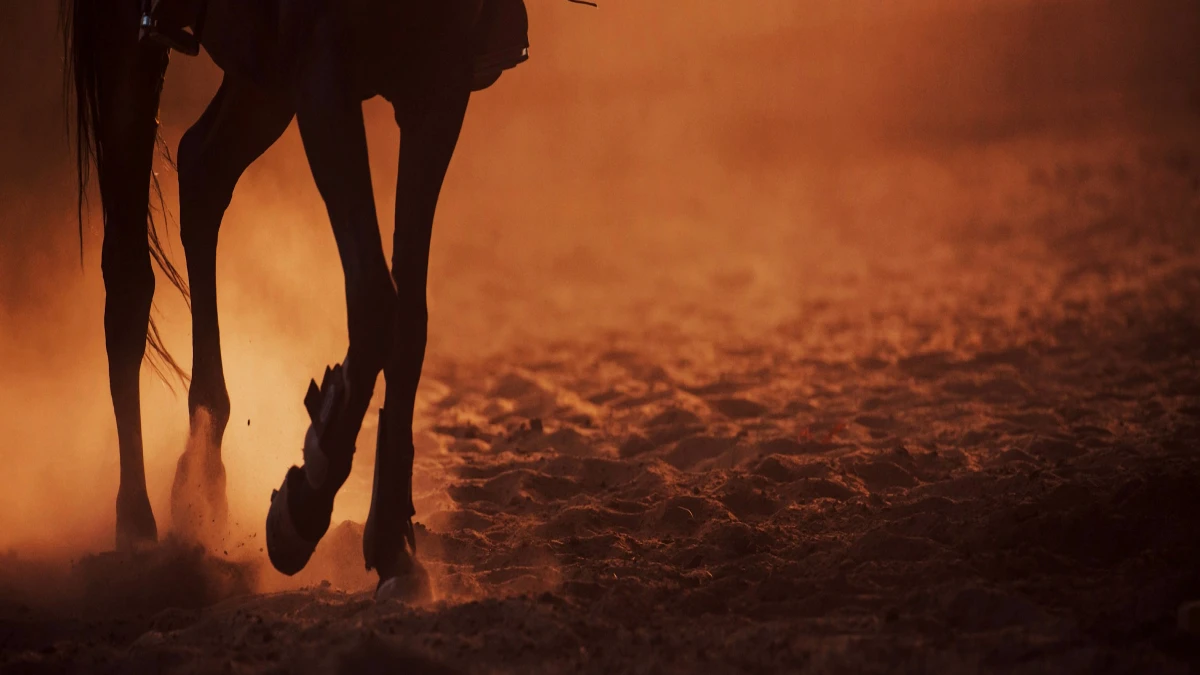Pawing: Causes, Consequences, and Management
Jul 22, 2023 by Jamie Finch

In the equestrian world, understanding and addressing behavioural issues in horses is essential for ensuring their well-being and maintaining a harmonious human-horse relationship.
One such behaviour that may concern horse owners, trainers, and caretakers is pawing.
Pawing, often characterised by striking the ground with a front hoof, can indicate underlying problems affecting a horse's physical and mental state.
This blog post will explore the causes, consequences, prevention strategies, and management techniques associated with equine pawing.
What is Pawing?
Pawing, also known as ground pawing or striking, refers to a behaviour in horses where they repetitively lift and strike the ground with a front hoof. The behaviour can range from mild and occasional to excessive and persistent, attracting attention from caretakers due to its potential impact on the horse's well-being.
Identifying pawing behaviour in horses is crucial for early intervention and understanding the potential issues affecting them.
Common Signs of Pawing
Horses exhibit various signs of pawing, which may include:
Striking the Ground: The most apparent sign of pawing is when a horse lifts and strikes the ground repeatedly with a front hoof, often in a rhythmic pattern.
Impatience and Frustration: Pawing can occur when a horse becomes impatient or frustrated, especially during feeding or waiting for attention or activity.
Repetitive Motion: The behaviour may persist over time and become a habitual response to certain situations or stressors.
Vocalisation: Some horses may vocalise while pawing, expressing their displeasure or discomfort.
Differentiating Pawing from Other Behaviours
Distinguishing pawing from other normal behaviours in horses is crucial to understanding the underlying issues and providing appropriate interventions.
Some behaviours that might be confused with pawing include:
Scratching: Horses may paw the ground when trying to scratch an itch on their leg or belly. However, scratching is typically a brief and occasional behaviour, while pawing is more repetitive and purposeful.
Foraging Behaviour: Horses may paw the ground to uncover buried food or access fresh grass in pastures. This behaviour is natural and different from the repetitive and frustrated pawing in other situations.
Discomfort or Pain: Pawing can also respond to physical discomfort or pain, especially when the horse is dealing with hoof problems or other injuries.
Common Causes of Pawing
Understanding the root causes of pawing behaviour is crucial for effective management and intervention.
Some common reasons why horses may exhibit pawing include:
Impatience or Frustration: Pawing can result from the horse's desire for attention, food, or activity. Horses may paw when they are eager for something or feel frustrated.
Separation Anxiety: Horses are social animals that form strong bonds with their herd mates. They may paw when separated from their companions due to anxiety and loneliness.
Pain or Discomfort: Pawing can respond to physical pain or discomfort, such as hoof problems, leg injuries, or sore muscles.
Boredom: Horses kept in stalls or confined spaces without mental and physical stimulation may resort to pawing to cope with boredom.
Prevention Strategies
Implementing preventive strategies can help reduce or eliminate pawing behaviour in horses.
Here are some essential steps to consider:
Regular Exercise and Turnout: Ensure horses receive sufficient daily exercise and turnout time in a suitable paddock or pasture. Regular movement and social interaction with other horses can help alleviate frustration and prevent pawing.
Environmental Enrichment: Provide a stimulating environment with toys, hanging objects, or treat puzzles to keep the horse mentally engaged and reduce boredom-related behaviours.
Addressing Pain or Discomfort: Regularly monitor the horse's health and promptly address any signs of pain or discomfort with the help of a veterinarian or equine specialist.
Social Interaction: Whenever possible, house horses in groups to provide companionship and reduce feelings of isolation and anxiety.
Positive Reinforcement: Use positive reinforcement techniques to reward calm and patient behaviour, reinforcing that pawing is not an acceptable way to get attention.
Conclusion
Pawing is a behaviour that may raise concerns among horse owners and caretakers due to its potential implications for a horse's well-being and safety.
By recognising early signs and implementing proactive prevention and management strategies, we can support our equine companions in leading happier lives. Combining environmental enrichment, regular exercise, addressing underlying issues, and positive reinforcement can create an environment where pawing is minimised, and our horses thrive, living a natural life.
Explore More Topics
Understanding Behavioural Changes in Horses
When a horse’s behaviour suddenly changes, it’s rarely without cause. This blog explores the physical, emotional, and environmental reasons behind behavioural shifts — and how owners can respond with understanding, clarity, and care.
May 31, 2025
10 Essential Groundwork Exercises to Improve Equine Agility
This blog post, "10 Essential Groundwork Exercises to Improve Equine Agility," provides a comprehensive guide for horse owners looking to enhance their horse's agility, coordination, and responsiveness through progressive groundwork. Each exercise includes step-by-step instructions, explains why the exercise is important for building trust, focus, and physical conditioning, and details how these skills translate into improved performance in agility courses and other equestrian pursuits.
Oct 28, 2024
Top Tips for First-Time Horse Owners: How Equine Insurance Can Give You Peace of Mind
Equine insurance is a crucial safety net for horse owners, providing financial protection against unexpected costs related to veterinary care, accidents, injuries, and liability claims. Whether you're a first-time owner or an experienced equestrian, insuring your horse offers peace of mind by covering expensive vet bills, public liability issues, theft, and even death.
Oct 23, 2024







